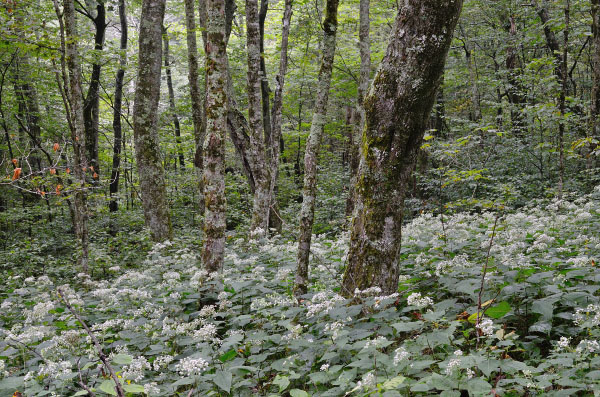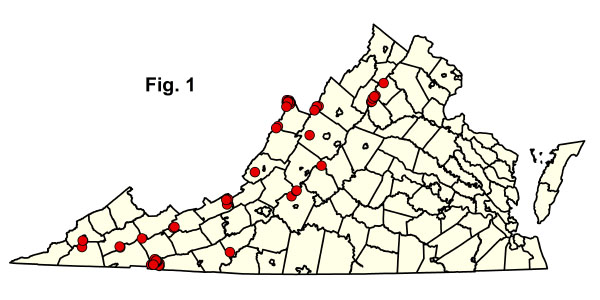
 Departamento de Conservación y Recreación (DCR)
Departamento de Conservación y Recreación (DCR) Conservar. Proteger. Disfrutar.
 Departamento de Conservación y Recreación (DCR)
Departamento de Conservación y Recreación (DCR)  Tabla de contenidos
Tabla de contenidosBosques de frondosas del norte
La vegetación de este grupo consiste en bosques mixtos de frondosas que se encuentran a grandes elevaciones (> 900 m [3,000 pies]) en el oeste de Virginia. Los ejemplos del sur de los Apalaches van desde las altas elevaciones de Carolina del Norte y Tennessee hasta el suroeste de Virginia y el este de Kentucky. Los ejemplos de los Apalaches centrales se extienden desde el suroeste de Virginia hacia el norte hasta las altas montañas Allegheny y la meseta no glaciar de Allegheny en el norte de Pensilvania y el sur de Nueva York.
Northern Hardwood Forest communities have distinct regional variation and floristic composition at a given site varies with geography and specific site conditions. Southern Appalachian Northern Hardwood Forests are prevalent throughout the high-elevation Mount Rogers-Whitetop Mountain (Balsam Mountains) area of the Southern Blue Ridge (Grayson, Smyth, and Washington Counties), with more local outliers at the highest elevations of the Iron Mountains (Grayson and Smyth Counties), Clinch Mountain (Russell, Smyth, Tazewell, and Washington Counties), and Black Mountain (Wise County) on the Kentucky border. Co-dominant trees in Southern Appalachian stands are sugar maple (Acer saccharum, American beech (Fagus grandifolia), yellow birch (Betula alleghaniensis), and yellow buckeye (Aesculus flava) in variable proportions. Fraser magnolia (Magnolia fraseri), eastern hemlock (Tsuga canadensis), and red spruce (Picea rubens) are important associate trees in some stands, particularly in the Mount Rogers - Whitetop area. Sapling sugar maple, striped maple (Acer pensylvanicum) and mountain maple (Acer spicatum) are common understory species. Smooth blackberry (Rubus canadensis) and hobblebush (Viburnum lantanoides) are common shrubs. Herb layers are moderately sparse to moderately dense, with graminoid-rich patches tending to occur on the drier slope convexities. Some of the most abundant herbs in the Southern Appalachian Northern Hardwood Forests are Appalachian white snakeroot (Ageratina altissima var. roanensis), southern lady fern (Athyrium asplenioides), evergreen wood fern (Dryopteris intermedia), mountain wood aster (Eurybia chlorolepis), sweet white violet (Viola blanda), and Appalachian woodland sedge (Carex austrolucorum).

Northern Hardwood stands in the Central Appalachians occur extensively at high elevations (>900 m [3,000 ft]) of Allegheny Mountain in Highland County, with smaller-patch outliers occurring on north-facing slopes over 1,070 m (3,500 ft) in the Blue Ridge, Ridge and Valley, and Cumberland Mountains, south to Tazewell, Russell, and Wise Counties. These are dominated by sugar maple, black cherry (Prunus serotina var. serotina), yellow birch, northern red oak (Quercus rubra), red maple (Acer rubrum), and sweet birch (Betula lenta var. lenta), while American beech, and eastern hemlock are less frequent co-dominants. Overstory composition varies occasionally to nearly pure sugar maple. Striped maple, mountain maple, and mountain holly (Ilex montana) are the chief understory species, along with sapling sugar maple and beech. The herb layers of many stands are characterized by patch-dominance of hayscented fern (Dennstaedtia punctilobula). Other more or less characteristic herbaceous species include whorled wood aster (Oclemena acuminata), evergreen wood fern (Dryopteris intermedia), prickly tree-clubmoss (Dendrolycopodium dendroideum, stiff clubmoss (Spinulum annotinum), tall millet grass (Milium effusum var. cisatlanticum), grove bluegrass (Poa alsodes), northern shorthusk (Brachyelytrum aristosum), purple oat grass (Schizachne purpurascens), sedges (particularly Carex appalachica, Carex flexuosa, Carex digitalis, Carex leptonervia, and Carex woodii), eastern rose mandarin (Streptopus lanceolatus), and sweet white violet (Viola blanda). The importance of red maple, sweet birch, northern red oak, and black cherry in contemporary Central Appalachian examples of this community group reflects secondary succession following catastrophic logging and fire disturbances in the early part of the twentieth century. Sugar maple and beech, both abundant in understory layers and locally co-dominant in the overstory, appear positioned to assume dominance as current secondary stands mature. However, beech-bark disease and excessive deer browsing are serious threats to the future viability of the largest stands on Allegheny Mountain .
En Virginia, varios pájaros cantores del norte, como la enredadera marrón (Certhia americana), la curruca de luto (Oporornis philadelphia) y el chupavia de vientre amarillo (Sphyrapicus varius), se reproducen solo en los bosques de frondosas del norte.
Referencias: Adams et. al . (2003), Coulling y Rawinski (1999), Fleming y Coulling (2001), Fleming y Moorhead (1996), Rawinski et al . (1996), Rheinhardt y Ware (1984).
Haga clic aquí para ver más fotos de este grupo comunitario ecológico.
 © DCR-DNH, Gary P. Fleming.
© DCR-DNH, Gary P. Fleming.
Los bosques de frondosas del norte han sido bien muestreados en Virginia, especialmente en el área de Mount Rogers-Whitetop de Southern Blue Ridge y en Allegheny Mountain en el condado de Highland. Hasta la fecha, se han muestreado 79 parcelas de este grupo en 18 condados (Fig. 1), aunque algunas de las unidades clasificadas están mejor respaldadas por los datos de parcelas que otras. Sin embargo, no es probable que un muestreo adicional cambie los conceptos básicos de estas unidades. Haga clic en cualquier código CEGL resaltado a continuación para ver la descripción global de USNVC proporcionada por NatureServe Explorer.

 Descargue una hoja de cálculo de estadísticas de resumen de composición para cada uno de los tipos de comunidad que se enumeran a continuación.
Descargue una hoja de cálculo de estadísticas de resumen de composición para cada uno de los tipos de comunidad que se enumeran a continuación.
Volver al principio de la página
siguiente Grupo Ecológico anterior Grupo Ecológico
